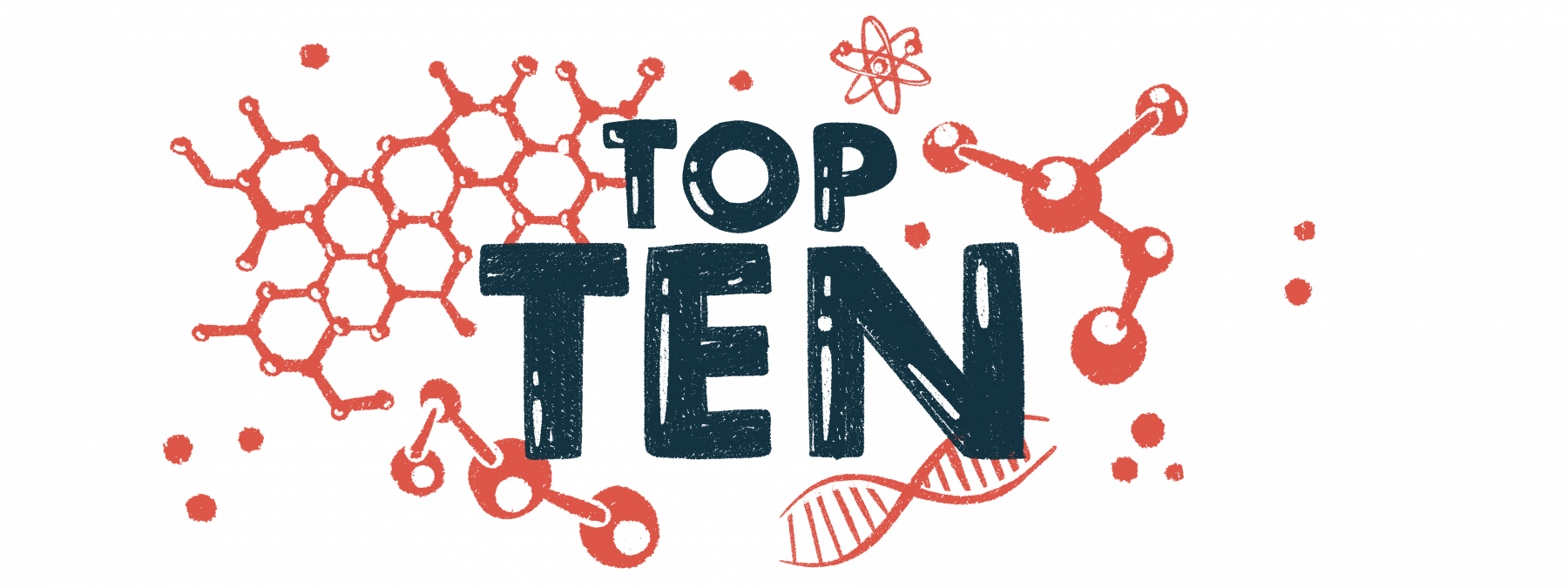Top 10 Pulmonary Fibrosis Stories of 2021

Pulmonary Fibrosis News brought you daily coverage throughout 2021 of the latest scientific findings, treatment developments, and clinical trials related to pulmonary fibrosis (PF).
As a reminder of what mattered most to you during the past year, here are the top 10 most-read articles of 2021, with a brief description of what made them interesting and relevant to the PF community.
We look forward to reporting more of this relevant news to patients, family members, and caregivers dealing with this disease during 2022.
No. 10 – “MDM4 Protein May Help to Treat PF by Clearing Cells That Drive Fibrosis”
Researchers in the U.S. found that suppressing a protein called MDM4 promoted the death of myofibroblasts — the main drivers of PF — and reversed persistent lung scarring in a mouse model of the disease. Produced by myofibroblasts, MDM4 is a mechanosensitive protein known to suppress the activity of a wound-healing molecule called p53. MDM4 was found at significantly higher levels in myofibroblasts from idiopathic pulmonary fibrosis (IPF) patients relative to healthy individuals. Further analyses in lab-grown human lung fibroblasts, the precursors of myofibroblasts, revealed that MDM4 was produced in response to the increased stiffness of the extracellular matrix (ECM) associated with IPF. The ECM is a network of molecules outside cells that provides structural and biochemical support — and that is overproduced by myofibroblasts and is unusually stiff in PF. These findings suggest that blocking MDM4 or targeting ECM may be new approaches to treating PF patients.
No. 9 – “Tyvaso Improved Lung Function in IPF Patients With PH”
A post-hoc analysis — an analysis done after a trial is over — of data from the Phase 2/3 INCREASE trial (NCT02630316) showed that four months of treatment with Tyvaso (inhaled treprostinil) significantly improved lung function in IPF patients with pulmonary hypertension. Delivered directly to the lungs through a portable handheld device, the United Therapeutics’ medicine lowers blood pressure by relaxing and widening blood vessels in the lungs. It is approved in the U.S. to treat pulmonary arterial hypertension and works to improve exercise ability in people with PH associated with interstitial lung disease (PH-ILD), which includes IPF. Previous top-line results from INCREASE, which involved 326 adults with PH-ILD, showed that Tyvaso was generally safe and worked better than a placebo at improving patients’ exercise capacity and reducing disease flares, or periods of sudden symptom worsening. Based on these positive findings, United is now assessing the therapy’s safety and effectiveness against a placebo in up to 396 IPF patients, ages 40 and older. That Phase 3 trial, called TETON (NCT04708782), was launched in June. The study is still enrolling at its U.S. sites; more information can be found here.
No. 8 – “Aria Reports Positive Preclinical Data for 2 New IPF Treatments”
Using a computer-based, artificial intelligence approach, Aria Pharmaceuticals identified two new therapeutic candidates for IPF that showed promising efficacy in a mouse model of the disease. The two compounds, TXR-1002 and TXR-1007, showed in August that they have good tolerability and can reduce lung scarring (fibrosis) and inflammatory cells to a degree at least comparable to that seen with Boehringer Ingelheim’s Ofev (nintedanib), an approved IPF therapy. The entire therapy discovery process — in which more than two million compounds were screened — took only about three months. That’s significantly faster than the years-long processes normally required with traditional treatment discovery approaches. Aria was working on the optimization of TXR-1002, which has a new mechanism of action compared with other therapies. Researchers said these new therapies might be able to help halt or reverse the disease’s progression.
No. 7 – “Natural Plant Antioxidant Protects Cells From Processes of IPF”
Researchers in China shed light on the mechanisms behind the previously reported anti-fibrotic effects of pterostilbene or PTE, an antioxidant found in blueberries, grapes, and other fruits. The team found that PTE prevented signs of IPF in two cellular models of the disorder by suppressing ASIC2, a protein that appeared to be as similarly damaging to cells as TGF-beta 1, a major pro-fibrotic molecule that is found at significantly higher levels in IPF patients. These findings suggest that PTE and other compounds targeting ASIC2 may have the potential to become future IPF treatments.
No. 6 – “Esopremazole for Acid Reflux May Ease IPF Inflammation, Scarring”
A team of researchers in the U.S. found that esopremazole, an acid reflux medication commonly used for gastroesophageal reflux disease (GERD), may be able to reduce lung fibrosis and inflammation in IPF. In lab-grown lung cells from healthy people and IPF patients, the therapy, a proton pump inhibitor or PPI, reduced the levels of enzymes involved in oxidative stress — which are overactive in IPF patients. Oxidative stress is an imbalance between the production of potentially harmful oxidant molecules and the cells’ ability to clear them with antioxidants. Esomeprazole also was found to activate a biological pathway involved in regulating pro-inflammatory and pro-fibrotic molecules, as well as cell growth and maturation — two processes impaired in IPF. Further analysis identified a set of 45 pro-fibrotic genes that are commonly overactive in IPF and whose activity was reduced by esopremazole. As such, esomeprazole and other PPIs may have beneficial effects in IPF patients by increasing antioxidant, anti-inflammatory, and anti-fibrotic molecules, according to researchers.
No. 5 – “Used in Chinese Medicine, Plant Compound Reduces Lung Scarring in Rats”
An inhaled or nebulized formulation of salvianolic acid B, called SAB — a natural compound found in red sage, also known as Danshen — reduced lung fibrosis in a rat model of IPF, researchers in China showed. SAB is often used in traditional Chinese medicine to ease symptoms of fibrotic or scarring disorders. In this study, rats treated with the compound showed fewer signs of lung damage and scarring relative to untreated animals. In addition, SAB was found to significantly increase the activity of two genes involved in preventing excessive blood clotting, which may help break down excess fibrin, the major component of blood clots, also found in fibrotic scars. These results support further evaluation of SAB as a potential IPF treatment.
No. 4 – “Blood Levels Marking Collagen Turnover May Predict IPF Severity”
A study in Denmark suggested that the degree of collagen turnover in the body could be used as a blood biomarker to predict the rate of disease progression in newly diagnosed IPF patients, regardless of antifibrotic treatment. Collagen is a major ECM molecule involved in wound healing and scarring; turnover is a balance between the production and degradation of a given molecule. By analyzing collagen turnover in the blood of 178 IPF patients enrolled in the real-world Pulmonary Fibrosis Biomarker study (NCT02772549), researchers found that those with higher levels of markers of both production and degradation were more likely to show disease progression at one year post-diagnosis in comparison with those with lower levels. Future studies are needed to clarify the predictive value of collagen turnover in IPF, according to researchers.
No. 3 – “N115 Nasal Spray Found to Improve Lung Function in PF Patients”
Treatment with a non-steroidal nasal spray called N115, by EmphyCorp, resulted in statistically and clinically significant improvements across all lung function parameters in people with PF, data from a Phase 3 trial showed. N115 is designed to reduce the risk of lung infections by increasing the production of a natural defense gas, nitric oxide, that kills disease-causing microbes. Besides the observed benefits in vital breathing ratios and oxygen levels, the experimental therapy allowed patients to breathe through the nose and sleep better, while reducing inflammation, congestion, cough, and fatigue. In two other Phase 3 studies, N115 also showed promise as a potential treatment of symptoms associated with COVID-19 infection.
No. 2 – “Daily Breathing Exercises Seen to Slow Progression in IPF Patients”
Adding simple breathing exercises to standard pharmacological treatment can slow lung function decline and improve quality of life in people with mild to moderate IPFA, a small study in China suggested. Developed specifically for IPF patients, the exercises involve slow and gentle arm movement while inhaling (raising arms) and exhaling (lowering arms) with repeated focused breathing, involving either the whole lungs, their lower part, or their upper region. The effects of such breathing exercises were tested in 82 people with IPF, who were randomly assigned to either complete the exercises in addition to usual care (39 patients) or receive standard care alone (43 patients) for up to one year. Participants in the exercise group showed significantly slower lung function decline, and greater lung volume and exercise capacity, as well as better quality of life and survival, compared with those given standard treatment alone. These findings support the use of this type of breathing exercises as an add-on approach in IPF patients.
No. 1 – “Vitamin D Eases Lung Fibrosis by Blocking RAS Pathway, Study Finds”
Our most-read article of 2021 concerned the discovery that vitamin D supplements lessen lung fibrosis in a mouse model of IPF. Such supplements worked by blocking the renin-angiotensin system (RAS), whose chronic activation is known to promote the production of pro-fibrotic molecules and the development of lung scarring. While increasing research supports vitamin D’s anti-fibrotic properties, this study shed new light on the underlying molecular mechanisms at play. Data showed that treatment with paricalcitol, an active form of vitamin D with low calcium-related activity, prevented disease-associated weight loss and significantly reduced lung fibrosis. This was found to be associated with the prevention of fibrosis-associated RAS activation. RAS is a signaling pathway mainly known for its role in regulating blood pressure, fluid, and salt balance in the body. Notably, similar benefits were observed when mice were treated with losartan, an approved blood pressure medication that works by suppressing RAS. These findings suggest that vitamin D supplements and RAS-suppressing therapies may help manage IPF.
***
At Pulmonary Fibrosis News we hope these stories and our reporting throughout 2021 help to better inform and improve the lives of everyone affected by PF.
We wish all our readers a happy 2022.









